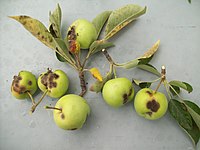
Photo from wikipedia
Ascospores of Venturia inaequalis, released from pseudothecia in overwintered, infected apple leaves, serve as the primary inoculum for apple scab. In this study, we tested a new sanitation strategy to… Click to show full abstract
Ascospores of Venturia inaequalis, released from pseudothecia in overwintered, infected apple leaves, serve as the primary inoculum for apple scab. In this study, we tested a new sanitation strategy to reduce ascospore inoculum under orchard conditions over three overwintering periods. After leaf fall, nutrient media containing different concentrations of degraded casein or a yeast extract from Saccharomyces cerivisiae were applied to leaf litter infected with apple scab. The application of 30 and 60% yeast extract showed the greatest efficacy, and significantly reduced ascospore discharge by 99% (P < 0.01) in 2013 and 2014. The efficacy of the treatments did not differ from treatment with 5% urea (P > 0.05). Leaf litter decay was accelerated in the plots treated with yeast extract compared with untreated control plots. Moreover, apple leaves treated with yeast extract had completely decayed due to earthworm activity before ascospore maturity. In comparison, up to 26% of the leaves in untreated control plots had not decayed. These results suggest that the treatment of leaf litter with yeast extract can almost completely eliminate apple scab inoculum in the course of the whole primary season. These sanitation practices may be beneficial for both organic and conventional cultivation. The reduced infection pressure may allow growers the usage of fungicides with lower efficacy or to reduce the number of applications needed to manage apple scab in spring.
Journal Title: Plant disease
Year Published: 2017
Link to full text (if available)
Share on Social Media: Sign Up to like & get
recommendations!